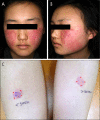Three Cases of Autoimmune Progesterone Dermatitis
- PMID: 28761298
- PMCID: PMC5500715
- DOI: 10.5021/ad.2017.29.4.479
Three Cases of Autoimmune Progesterone Dermatitis
Retraction in
-
Retraction: Three Cases of Autoimmune Progesterone Dermatitis.Ann Dermatol. 2022 Apr;34(2):161. doi: 10.5021/ad.2022.34.2.161. Epub 2022 Mar 24. Ann Dermatol. 2022. PMID: 35450311 Free PMC article.
Abstract
Autoimmune progesterone dermatitis is a rare cyclic premenstrual reaction to progesterone produced during the luteal phase of the menstrual cycle. The clinical symptoms of autoimmune progesterone dermatitis overlap with other forms of dermatosis such as erythema multiforme, eczema, fixed drug eruption, urticaria, and angioedema. We experienced 3 cases of autoimmune progesterone dermatitis. All patients had a recurrent history of monthly skin eruptions. Skin lesions normally began a few days before menstruation and resolved a few days later. Patients were confirmed to have autoimmune progesterone dermatitis by the results of the progesterone intradermal test. All three patients had different clinical findings such as erythema annulare centrifugum, urticaria, contact dermatitis, and rosacea. Because patients presented with variable clinical manifestations, they could have been easily misdiagnosed. The patients were treated with oral contraceptive, antihistamine and steroids for symptom control. We propose that dermatologists should consider autoimmune progesterone dermatitis in cases of recurrent cyclic skin eruptions in female patients. Further, if this condition is suspected, thorough history taking including that on menstrual cycle and intradermal progesterone test should be performed.
Keywords: Autoimmune progesterone dermatitis; Menstrual cycle; Progesterone.
Conflict of interest statement
CONFLICTS OF INTEREST: The authors have nothing to disclose.
Figures



Similar articles
-
Autoimmune Progesterone Dermatitis Diagnosed by Lymphocyte Transformation Test and Progesterone Provocation Test.Acta Dermatovenerol Croat. 2018 Oct;26(3):276-277. Acta Dermatovenerol Croat. 2018. PMID: 30390735
-
Autoimmune progesterone dermatitis presenting as fixed drug eruption: a case report.Dermatol Online J. 2017 Jun 15;23(6):13030/qt685685p4. Dermatol Online J. 2017. PMID: 28633739
-
Autoimmune progesterone dermatitis and stomatitis.Oral Surg Oral Med Oral Pathol Oral Radiol Endod. 1998 May;85(5):537-41. doi: 10.1016/s1079-2104(98)90287-6. Oral Surg Oral Med Oral Pathol Oral Radiol Endod. 1998. PMID: 9619670
-
Autoimmune progesterone dermatitis and its manifestation as anaphylaxis: a case report and literature review.Ann Allergy Asthma Immunol. 2003 May;90(5):469-77; quiz 477, 571. doi: 10.1016/S1081-1206(10)61838-8. Ann Allergy Asthma Immunol. 2003. PMID: 12775127 Review.
-
Autoimmune progesterone dermatitis.J Am Acad Dermatol. 1995 Feb;32(2 Pt 2):333-8. doi: 10.1016/0190-9622(95)90398-4. J Am Acad Dermatol. 1995. PMID: 7829735 Review.
Cited by
-
Autoimmune progesterone dermatitis following vaginal progesterone exposure in pregnancy.Obstet Med. 2019 Jun;12(2):100-102. doi: 10.1177/1753495X18771255. Epub 2018 May 4. Obstet Med. 2019. PMID: 31217816 Free PMC article.
-
Autoimmune Progesterone Dermatitis: A Case Report.Rev Bras Ginecol Obstet. 2019 Mar;41(3):203-205. doi: 10.1055/s-0039-1678589. Epub 2019 Apr 2. Rev Bras Ginecol Obstet. 2019. PMID: 30939605 Free PMC article.
-
Piroxicam-induced fixed drug eruption in a patient with cystic acne.Hippokratia. 2017 Jan-Mar;21(1):61. Hippokratia. 2017. PMID: 29904264 Free PMC article. No abstract available.
-
A Case of Autoimmune progesterone dermatitis post-intrauterine device placement in rural occupied Palestine.SAGE Open Med Case Rep. 2024 Sep 24;12:2050313X241283601. doi: 10.1177/2050313X241283601. eCollection 2024. SAGE Open Med Case Rep. 2024. PMID: 39345830 Free PMC article.
-
Catamenial dermatoses associated with autoimmune, inflammatory, and systemic diseases: A systematic review,.Int J Womens Dermatol. 2019 Oct 25;5(5):361-367. doi: 10.1016/j.ijwd.2019.09.008. eCollection 2019 Dec. Int J Womens Dermatol. 2019. PMID: 31909158 Free PMC article. Review.
References
-
- Herzberg AJ, Strohmeyer CR, Cirillo-Hyland VA. Autoimmune progesterone dermatitis. J Am Acad Dermatol. 1995;32:333–338. - PubMed
-
- Walling HW, Scupham RK. Autoimmune progesterone dermatitis. Case report with histologic overlap of erythema multiforme and urticaria. Int J Dermatol. 2008;47:380–382. - PubMed
-
- Asai J, Katoh N, Nakano M, Wada M, Kishimoto S. Case of autoimmune progesterone dermatitis presenting as fixed drug eruption. J Dermatol. 2009;36:643–645. - PubMed
-
- Halevy S, Cohen AD, Lunenfeld E, Grossman N. Autoimmune progesterone dermatitis manifested as erythema annulare centrifugum: confirmation of progesterone sensitivity by in vitro interferon-gamma release. J Am Acad Dermatol. 2002;47:311–313. - PubMed
Publication types
LinkOut - more resources
Full Text Sources
Other Literature Sources

